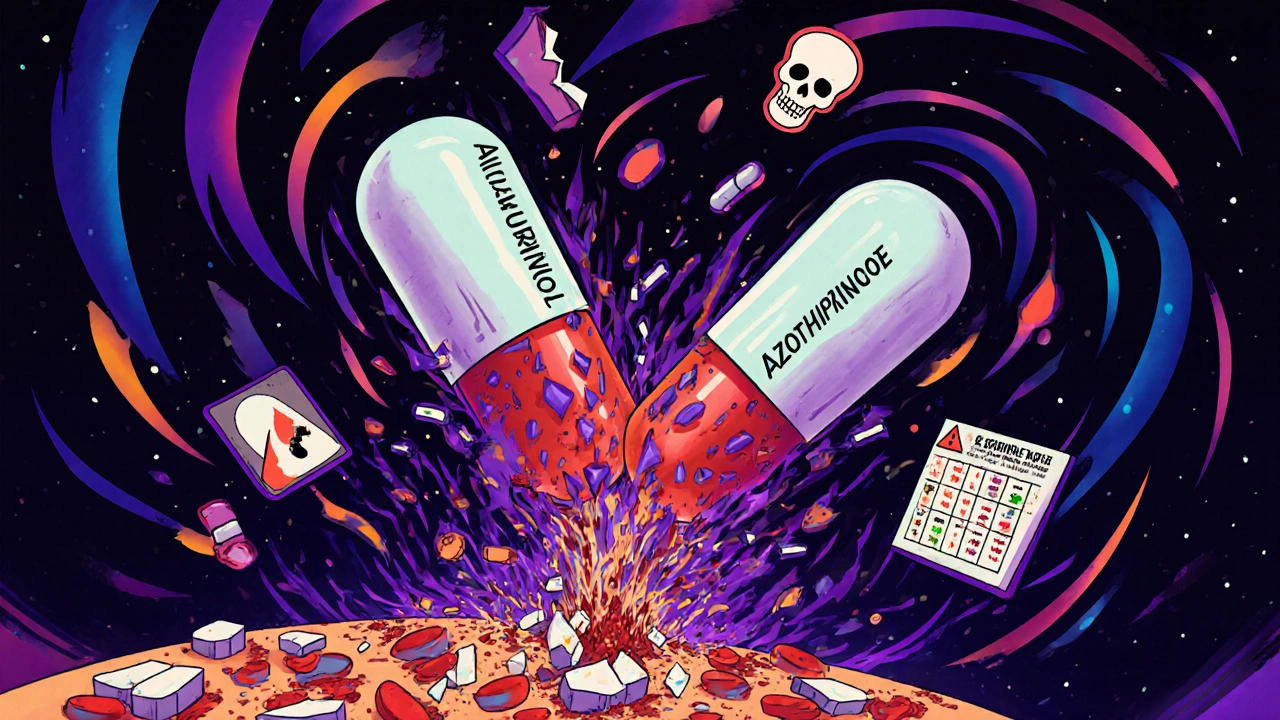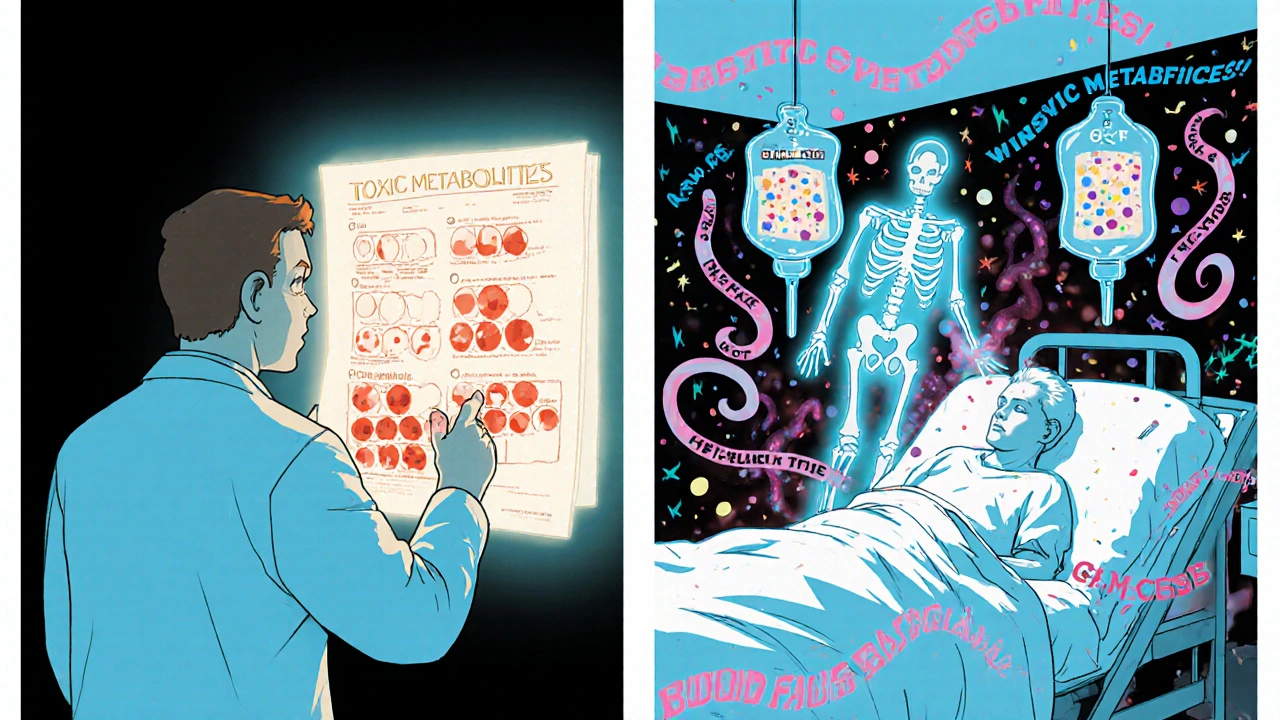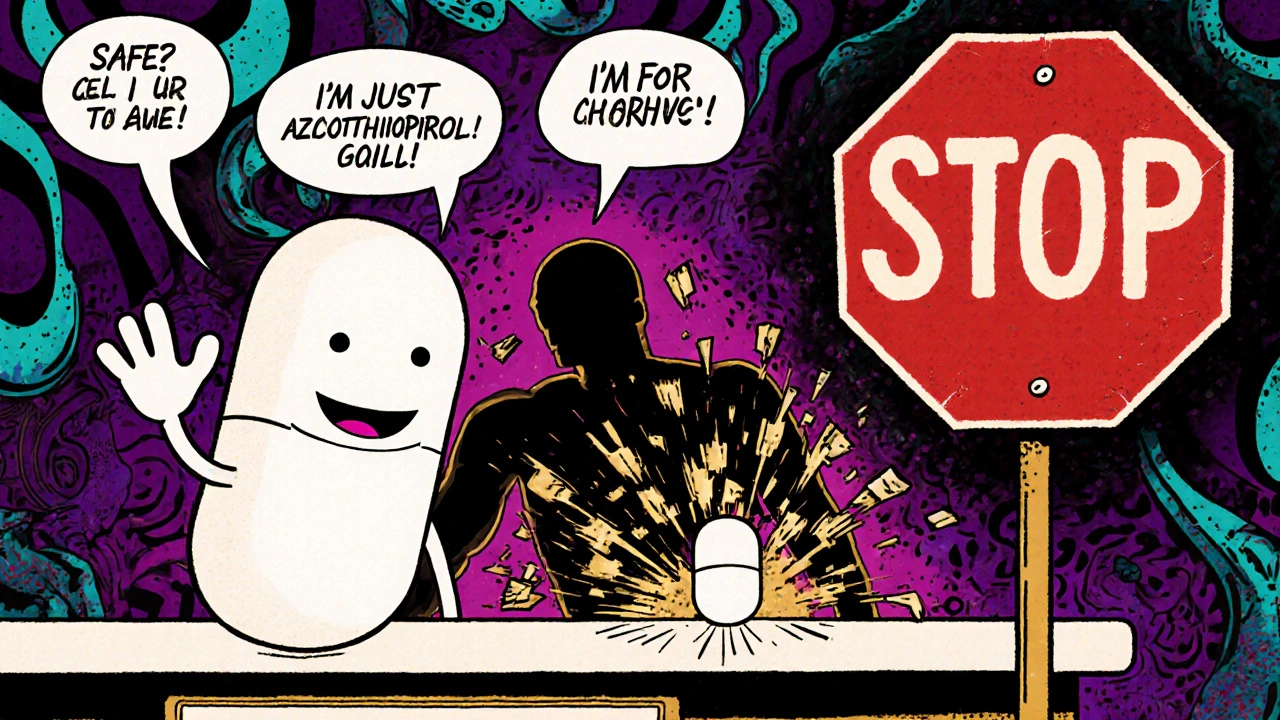
Combining allopurinol and azathioprine can be deadly - not because either drug is inherently dangerous, but because together, they can shut down your bone marrow. This isn’t a theoretical risk. It’s a well-documented, life-threatening interaction that has sent patients to the ICU, required blood transfusions, and cost tens of thousands in hospital bills. And yet, many doctors still miss it.
Why This Interaction Is So Dangerous
Allopurinol is a common gout medication. It lowers uric acid by blocking an enzyme called xanthine oxidase. Azathioprine is an immunosuppressant used for Crohn’s disease, ulcerative colitis, rheumatoid arthritis, and after organ transplants. At first glance, they seem unrelated. But inside your body, they collide. Azathioprine doesn’t work directly. It breaks down into 6-mercaptopurine (6-MP), which then gets processed by three enzymes. One of them - xanthine oxidase - is the exact enzyme that allopurinol blocks. When that enzyme is turned off, 6-MP can’t be broken down properly. Instead, it piles up and gets converted into toxic compounds that attack your bone marrow. The result? Your body stops making enough white blood cells, red blood cells, and platelets. White blood cell counts can drop below 1,100 per mm³ (normal is 4,000-11,000). Neutrophils - the cells that fight infection - can fall below 500. Platelets may crash to 20,000 or lower. Hemoglobin can plunge to 3.7 g/dL. That’s severe anemia. That’s life-threatening infection risk. That’s hospitalization. In a 1996 case report, a 63-year-old heart transplant patient on azathioprine was given allopurinol for what was thought to be gout. Within weeks, he developed pancytopenia. He needed four units of blood and a drug called GM-CSF just to restart his bone marrow. His hospital bill? Over $25,000 in today’s money.What Happens in Your Body When These Drugs Mix
It’s not just one pathway that goes wrong. It’s two. First, allopurinol blocks the normal cleanup route for 6-MP. That alone would be bad enough. But then, the unused 6-MP gets redirected into another pathway that creates even more toxic metabolites - thioguanine nucleotides (6-TGNs). These get built into your DNA, especially in rapidly dividing cells like those in your bone marrow. That stops cell division. That kills white blood cells. At the same time, allopurinol also suppresses a protein called Rac1, which normally helps white blood cells survive. So you’re not just stopping new cells from being made - you’re killing the ones already there. Studies show this combination can increase 6-MP levels by up to four times. That’s not a small change. That’s a tsunami of toxicity. One study found that when allopurinol was added, 6-MMP (a less harmful metabolite) dropped by 70%. That means almost all the drug is being forced into the dangerous pathway.When Is This Combination Ever Used?
Despite the risks, some specialists use this combo - but only in very specific cases. About 25-30% of people with inflammatory bowel disease (IBD) are called “thiopurine shunters.” Their bodies turn azathioprine into a liver-toxic metabolite (6-MMP) instead of the helpful one (6-TGN). So they get sick from the drug without getting better. For these patients, adding a low dose of allopurinol can redirect the drug toward the therapeutic pathway. In a 2018 trial, 53% of IBD patients on this combo achieved steroid-free remission. That’s a big win for people who’ve run out of options. But here’s the catch: this only works under strict control. Azathioprine must be cut to 25% of the normal dose - usually 0.5-0.75 mg per kg of body weight. Allopurinol is started at 100 mg daily. Blood tests must be done weekly for the first three months. Liver and metabolite levels need tracking. This isn’t something a general practitioner should handle. It requires a gastroenterologist or a pharmacist trained in thiopurine metabolism.
What Doctors Should Do Before Prescribing
If you’re on azathioprine, your doctor should check one thing before prescribing anything else: are you taking allopurinol? Or could you need it? The Medsafe guidelines (New Zealand’s drug safety authority) say this outright: “When azathioprine is initiated, the prescriber should check that the patient is not taking allopurinol.” That’s not a suggestion. That’s a requirement. The FDA’s label for azathioprine includes a black box warning - the strongest kind - about this interaction. It says: “Concomitant use may lead to severe, life-threatening bone marrow suppression.” That warning exists because people keep dying from this. If you have gout and are on azathioprine, don’t assume allopurinol is safe. Ask your doctor: “Is there a safer way to treat my gout?” Alternatives like febuxostat don’t block xanthine oxidase the same way. Pegloticase is another option for severe gout. Neither carries this risk.What You Should Do If You’re Taking Both
If you’re already on both drugs - stop. Don’t wait. Call your doctor today. Don’t stop azathioprine on your own - that could cause a flare. But don’t take another dose of allopurinol until you’ve talked to your provider. If you’re being monitored for this combo under specialist care, make sure you’re getting:- Weekly complete blood counts for the first month
- Monthly blood tests after that
- Thiopurine metabolite testing (6-TGN and 6-MMP levels)
- Regular liver function tests

Who’s at Highest Risk?
People with low or intermediate levels of TPMT (thiopurine methyltransferase) enzyme are more vulnerable. About 10% of the population has this genetic variation. Their bodies can’t process 6-MP well even without allopurinol. Add allopurinol, and the risk skyrockets. Older adults are also at higher risk. Many have gout and are on immunosuppressants after transplants. They’re often on multiple medications. Their kidneys may not clear drugs as well. And they’re less likely to get frequent blood tests.What’s Changing in Treatment Guidelines
The American College of Gastroenterology now gives a conditional recommendation for using this combo in IBD patients who are thiopurine shunters. That’s progress. But they also stress it’s only for specialists. Meanwhile, research is moving toward precision dosing. The TAILOR-IBD trial (2023) is testing whether tailoring the dose based on metabolite levels can make this safer. Early results show 68% remission rates at 12 months - with no unexpected deaths. But here’s the reality: most patients won’t ever need this combo. And most doctors won’t be able to manage it safely. The safer path is always to avoid the interaction entirely.What to Ask Your Doctor
If you have gout and are on azathioprine, 6-mercaptopurine, or cyclophosphamide, ask:- “Is there a gout medication that doesn’t interact with my current drug?”
- “Have you checked for this interaction in my chart?”
- “Could I be a thiopurine shunter?”
- “Would testing my TPMT or metabolite levels help?”
Can allopurinol and azathioprine be taken together safely?
Only under strict specialist supervision and with major dose reductions. Azathioprine must be cut to 25% of the normal dose, and blood counts must be checked weekly. For most people, the risk outweighs any benefit. Avoid combining them unless you’re under care of a gastroenterologist or transplant specialist with experience in thiopurine metabolism.
What are the signs of bone marrow suppression from this interaction?
Watch for unexplained fatigue, frequent infections, fever, easy bruising or bleeding, pale skin, or shortness of breath. These can signal low white blood cells, platelets, or red blood cells. If you’re on both drugs and notice any of these, get a blood test immediately. Don’t wait.
Is febuxostat safer than allopurinol if I’m on azathioprine?
Yes. Febuxostat lowers uric acid but doesn’t block xanthine oxidase the same way allopurinol does. It doesn’t interfere with azathioprine metabolism. It’s a safer alternative for gout patients on immunosuppressants. Talk to your doctor about switching.
How common is this dangerous interaction?
It’s rare in the general population, but the risk is high for people on both drugs. Around 9.2 million Americans have gout, and 1.6 million have IBD. With 25-30% of IBD patients being thiopurine shunters, up to half a million could be at risk if both drugs are prescribed without checking. Most cases are preventable with basic screening.
Why do some doctors still prescribe this combination?
Some don’t know the risk. Others use it intentionally for IBD patients who don’t respond to standard doses - but only in specialized centers. A 2021 survey found only 32% of U.S. gastroenterologists have ever used this combo. Most avoid it. When it’s used, it’s because the patient has no other options - and the team has the expertise to monitor it closely.
8 Comments
Robert Gilmore November 30, 2025 AT 05:49
Bro this is wild. I had no idea allopurinol could do this to azathioprine. I’m on azathioprine for my Crohn’s and my doc just gave me allopurinol for gout last week 😳 I’m calling them first thing tomorrow. Thanks for the heads up!!
Robert Gilmore December 1, 2025 AT 18:47
They’re hiding this on purpose. Big Pharma doesn’t want you to know you can get free gout meds that don’t kill you. They profit off bone marrow transplants and ICU stays. Read the FDA label again. That black box? That’s a murder warrant. 🤡
Robert Gilmore December 2, 2025 AT 05:07
Wow. So you’re telling me the average GP doesn’t even know this? That’s not incompetence-that’s criminal negligence. I’ve seen this exact combo prescribed in three different clinics. One guy died. His family sued. The hospital settled. No one got fired. Welcome to American medicine. 🤬
Robert Gilmore December 3, 2025 AT 00:20
Oh wow, so you're telling me the same enzyme that breaks down uric acid also handles immunosuppressants? Shocking. 🙄 Next you'll tell me water is wet. At least in India, we learn this in med school year one. But hey, good for you Americans for catching up... 30 years late.
Robert Gilmore December 4, 2025 AT 07:41
Hey everyone, I’m a pharmacist and I’ve managed this combo in 12 IBD patients. It’s scary but WORKS when done right. I know it sounds like a horror story-but for some folks, it’s the only way to avoid steroids or biologics. The key? Dose down azathioprine to 0.5 mg/kg, check bloods weekly, track 6-TGN levels. And yes, febuxostat is safer. But if you’re a shunter? This combo can save your life. Don’t panic. Just get informed. 💪
Robert Gilmore December 5, 2025 AT 20:05
Just read this whole thing. I’m on azathioprine for RA and got gout last month. My doc prescribed allopurinol. I didn’t even know they could interact. I’m gonna print this out and hand it to him. Seriously, this needs to be in every med school textbook.
Robert Gilmore December 7, 2025 AT 02:57
This is one of those posts that makes you realize how fragile our health system is. Someone could die because a doctor didn’t check a drug interaction. It’s not about blame-it’s about awareness. Thank you for writing this with such clarity. I’m sharing this with my entire book club. We’re all on something. We need to know this.
Robert Gilmore December 7, 2025 AT 14:27
It’s not the drugs that are evil... it’s the illusion of control. We think we can outsmart biology with pills. But the body remembers. It knows when you force two things together that were never meant to coexist. Allopurinol and azathioprine? That’s not a medical decision. That’s a metaphysical error. You’re not treating gout-you’re playing god with your marrow. And god? He doesn’t forgive mistakes. 😔